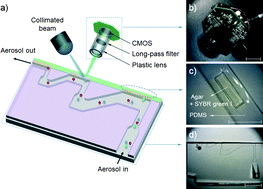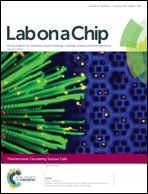Real-time detection of an airborne microorganism using inertial impaction and mini-fluorescent microscopy
Abstract
To achieve successful real-time detection of airborne pathogenic microorganisms, the problem must be considered in terms of their physical size and biological characteristics. We developed an airborne microorganism detection chip to realize the detection of microorganisms, ensuring compactness, sensitivity, cost-efficiency, and portability, using three key components: an inertial impaction system, a cartridge-type impaction plate, and a mini-fluorescent microscope. The inertial impaction system was used to separate microorganisms in terms of their aerodynamic particle size, and was fabricated with three impaction stages. Numerical analysis was performed to design the system; the calculated cutoff diameter at each impaction stage was 2.02 (first stage), 0.88 (second stage), and 0.54 μm (third stage). The measured cutoff diameters were 2.24, 0.91, and 0.49 μm, respectively. A cartridge-type impaction plate was used, composed of molded polydimethylsiloxane (PDMS) and an actual impaction region made of a SYBR green I dye-stained agar plate. A mini-fluorescent microscope was used to distinguish microbes from non-biological particles. Images of the microorganisms deposited at the impaction zone were obtained via mini-fluorescent microscopy, and fluorescent intensities of the images were calculated using in-house image-processing software. The results showed that the developed system successfully identified aerosolized biological particles from non-biological particles in real time.


 Please wait while we load your content...
Please wait while we load your content...